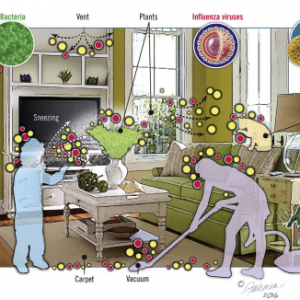So our collaborators from the Biology of the Built Environment (BioBE) Center at the University of Oregon have been working hard to get their environmental sampling qRT-PCR assays for SARS-CoV-2 up and running. I’m sure we’ll be posting more about their results as they develop. But they are now offering their testing as a service …
Posted by request from the BioBE Center at the University of Oregon: The work of our BioBE team will be represented at five different conferences from May to August 2020. Our projects on hospital-associated infection will be presented at American Society for Microbiology Conference in Chicago, Microbiology in the Built Environment in Andover, NH, …
This highly-anticipated study on the effect of natural daylight treatments on whole bacterial communities in household dust from the University of Oregon’s Biology and the Built Environment Center is now available! Daylight exposure modulates bacterial communities associated with household dust Ashkaan K. Fahimipour , Erica M. Hartmann, Andrew Siemens, Jeff Kline, David A. Levin, Hannah Wilson, Clarisse …
A recent open access paper from the BioBE Center at University of Oregon explored the differences between airborne bacteria collected in parks and parking lots. Entitled “Urban greenness influences airborne bacterial community composition” and published in Science of the Total Environment, this interdisciplinary study combined research methods from microbiology and landscape architecture to answer the …
During the winter term at University of Oregon, I led a design-oriented microbiome course for graduate and undergraduate students from a variety of disciplines (Architecture, Environmental Studies, Landscape Architecture, and Planning). Just for the record, these design students were VERY enthusiastic to learn about microbiome science, although they were somewhat disconcerted to find out how …
By Amanda Makowiecki 1st Year Mechanical Engineering PhD Student Miller Research Group, University of Colorado Boulder Researchers at the University of Oregon recently published a paper examining the connection between architectural design and microbial diversity in our buildings (Kembel et al. 2014). Although occupancy type was identified as the strongest predictor of microbial variation, several …
The University of Oregon’s Biology and the Built Environment Center has been chosen by the American Institute of Architects (AIA), the AIA Foundation, and the Association of Collegiate Schools of Architecture to be a charter member of the AIA Design & Health Research Consortium. The eleven Consortium members are university-led teams of architecture and public …
Just a quick post here. Found this news story (from Nov 18) doing some Google Searchers: UO student gets EPA grant to study health link between plants, people – Portland Business Journal. It discusses a new grant on “Relationships Among Airborne Microbial Communities, Urban Land Uses and Vegetation Cover: Implications for Urban Planning and Human Health.” …
Well, who would have thought. Just yesterday a paper came out from the BioBE Center on how the microbes on cell phones reflect the microbiome of the person using the phone (Meadow JF, Altrichter AE, Green JL. (2014) Mobile phones carry the personal microbiome of their owners. PeerJ 2:e447). In the paper they comment …
Great article from Brooke Borel writing for NOVA Online, “Manipulating the Unseen Microbial Ecosystem–The Future of Hospitals?”. This covers some of the background of microbiology in hospitals, discusses work by both the BioBE Center and microBEnet… and of course the Hospital Microbiome Project as well as the NICU study from Jill Banfield’s lab. The article …
